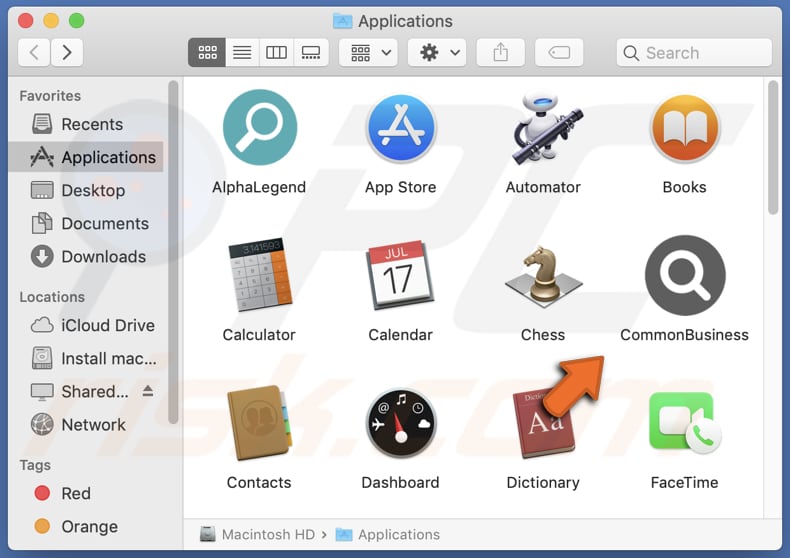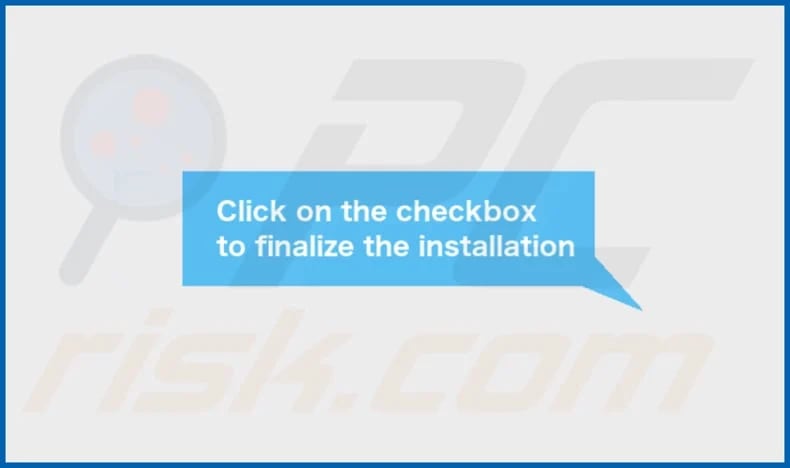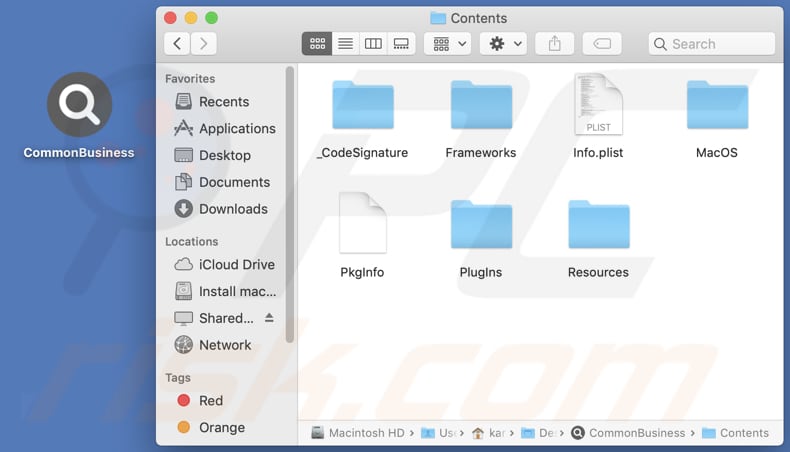Get free scan and check if your device is infected.
Remove it nowTo use full-featured product, you have to purchase a license for Combo Cleaner. Seven days free trial available. Combo Cleaner is owned and operated by RCS LT, the parent company of PCRisk.com.
What kind of application is CommonBusiness?
Upon evaluating the CommonBusiness application, we have observed its frequent display of intrusive advertisements, categorizing it as adware. Users frequently install such applications like CommonBusiness without a full understanding of the potential consequences they may encounter. Such apps should not be trusted.

CommonBusiness adware in detail
Applications like CommonBusiness commonly showcase a broad array of advertisements, often causing significant disruptions and intrusions into the user experience. These advertisements frequently manifest as pop-up windows, banners, or even full-screen interstitials, significantly interfering with tasks and potentially causing unintended clicks that can redirect users to undesired pages.
Additionally, certain adware utilizes tracking methods to gather user data, encompassing browsing patterns and personal information, with the aim of delivering personalized ads. Moreover, gathered data can be used for malicious purposes.
This practice can give rise to significant privacy apprehensions. Furthermore, adware advertisements often adopt a deceptive approach, enticing users with promises of alluring deals, discounts, or prizes as bait to encourage them to click on these ads.
Engaging with ads presented by applications such as CommonBusiness can result in users being directed to potentially hazardous websites or coerced into installing additional unwanted software. Moreover, adware has the potential to impede device performance, causing a slowdown and utilizing valuable system resources, which can exacerbate user frustration.
The advertisements exhibited by adware like CommonBusiness are irritating and present substantial risks to users' online security and overall digital experience. Consequently, it is strongly recommended to uninstall CommonBusiness or any comparable applications from affected computers.
| Name | Ads by CommonBusiness |
| Threat Type | Adware, Mac malware, Mac virus |
| Detection Names | Avast (MacOS:AdAgent-L [Adw]), Combo Cleaner (Gen:Variant.Adware.MAC.AdLoad.8), ESET-NOD32 (A Variant Of OSX/Adware.Synataeb.C), Kaspersky (Not-a-virus:HEUR:AdWare.OSX.Adload.h), Full List (VirusTotal) |
| Additional Information | This application belongs to Adload malware family. |
| Symptoms | Your Mac becomes slower than normal, you see unwanted pop-up ads, you are redirected to dubious websites. |
| Distribution methods | Deceptive pop-up ads, free software installers (bundling), torrent file downloads. |
| Damage | Internet browser tracking (potential privacy issues), display of unwanted ads, redirects to dubious websites, loss of private information. |
| Malware Removal (Windows) |
To eliminate possible malware infections, scan your computer with legitimate antivirus software. Our security researchers recommend using Combo Cleaner. Download Combo CleanerTo use full-featured product, you have to purchase a license for Combo Cleaner. 7 days free trial available. Combo Cleaner is owned and operated by RCS LT, the parent company of PCRisk.com. |
Conclusion
In summary, CommonBusiness poses an enduring and troublesome issue in the digital environment. This application overwhelms users with disruptive ads, and beyond the annoyance it brings, adware introduces substantial privacy and security worries by harvesting user data and potentially subjecting users to malicious content.
It is crucial to emphasize that applications like CommonBusiness have the capacity to function as browser hijackers, making changes to browser settings. Typically, browser hijacking involves the promotion of fake search engines.
More examples of apps like CommonBusiness AdvancedUpdater, ParameterLog, and NodeZipArray.
How did CommonBusiness install on my computer?
Adware can infiltrate users' computers through multiple entry points, with a frequent pathway being through freeware or shareware obtained from unreliable websites or alternative sources. Certain free software packages include concealed adware components, often found in settings like "Custom" or "Advanced," which users might overlook during software installations.
Furthermore, engaging with deceptive advertisements or pop-up notifications, particularly those masquerading as software updates or security alerts, can trigger the installation of adware. Additionally, interacting with suspicious email attachments or links can install adware.
How to avoid installation of unwanted applications?
Exercise caution when encountering suspicious advertisements and pop-up notifications. Refrain from clicking on questionable links or downloading files from shady sources. Decline requests for notifications from dubious websites when prompted.
Ensure that you exclusively download software from trustworthy sources such as the Apple App Store and official pages. Take the time needed to carefully review installation prompts, and avoid hurrying through the process, as adware could potentially be bundled with other software.
If your computer is already infected with CommonBusiness, we recommend running a scan with Combo Cleaner Antivirus for Windows to automatically eliminate this adware.
A message that appears after the installation of CommonBusiness adware:

The installation folder of CommonBusiness:

Instant automatic malware removal:
Manual threat removal might be a lengthy and complicated process that requires advanced IT skills. Combo Cleaner is a professional automatic malware removal tool that is recommended to get rid of malware. Download it by clicking the button below:
DOWNLOAD Combo CleanerBy downloading any software listed on this website you agree to our Privacy Policy and Terms of Use. To use full-featured product, you have to purchase a license for Combo Cleaner. 7 days free trial available. Combo Cleaner is owned and operated by RCS LT, the parent company of PCRisk.com.
Quick menu:
- What is CommonBusiness?
- STEP 1. Remove CommonBusiness related files and folders from OSX.
- STEP 2. Remove CommonBusiness ads from Safari.
- STEP 3. Remove CommonBusiness adware from Google Chrome.
- STEP 4. Remove CommonBusiness ads from Mozilla Firefox.
Video showing how to remove CommonBusiness adware using Combo Cleaner:
CommonBusiness adware removal:
Remove CommonBusiness-related potentially unwanted applications from your "Applications" folder:

Click the Finder icon. In the Finder window, select "Applications". In the applications folder, look for "MPlayerX", "NicePlayer", or other suspicious applications and drag them to the Trash. After removing the potentially unwanted application(s) that cause online ads, scan your Mac for any remaining unwanted components.
DOWNLOAD remover for malware infections
Combo Cleaner checks if your computer is infected with malware. To use full-featured product, you have to purchase a license for Combo Cleaner. 7 days free trial available. Combo Cleaner is owned and operated by RCS LT, the parent company of PCRisk.com.
Remove adware-related files and folders

Click the Finder icon, from the menu bar. Choose Go, and click Go to Folder...
 Check for adware generated files in the /Library/LaunchAgents/ folder:
Check for adware generated files in the /Library/LaunchAgents/ folder:

In the Go to Folder... bar, type: /Library/LaunchAgents/

In the "LaunchAgents" folder, look for any recently-added suspicious files and move them to the Trash. Examples of files generated by adware - "installmac.AppRemoval.plist", "myppes.download.plist", "mykotlerino.ltvbit.plist", "kuklorest.update.plist", etc. Adware commonly installs several files with the exact same string.
 Check for adware generated files in the ~/Library/Application Support/ folder:
Check for adware generated files in the ~/Library/Application Support/ folder:

In the Go to Folder... bar, type: ~/Library/Application Support/

In the "Application Support" folder, look for any recently-added suspicious folders. For example, "MplayerX" or "NicePlayer", and move these folders to the Trash.
 Check for adware generated files in the ~/Library/LaunchAgents/ folder:
Check for adware generated files in the ~/Library/LaunchAgents/ folder:

In the Go to Folder... bar, type: ~/Library/LaunchAgents/

In the "LaunchAgents" folder, look for any recently-added suspicious files and move them to the Trash. Examples of files generated by adware - "installmac.AppRemoval.plist", "myppes.download.plist", "mykotlerino.ltvbit.plist", "kuklorest.update.plist", etc. Adware commonly installs several files with the exact same string.
 Check for adware generated files in the /Library/LaunchDaemons/ folder:
Check for adware generated files in the /Library/LaunchDaemons/ folder:

In the "Go to Folder..." bar, type: /Library/LaunchDaemons/

In the "LaunchDaemons" folder, look for recently-added suspicious files. For example "com.aoudad.net-preferences.plist", "com.myppes.net-preferences.plist", "com.kuklorest.net-preferences.plist", "com.avickUpd.plist", etc., and move them to the Trash.
 Scan your Mac with Combo Cleaner:
Scan your Mac with Combo Cleaner:
If you have followed all the steps correctly, your Mac should be clean of infections. To ensure your system is not infected, run a scan with Combo Cleaner Antivirus. Download it HERE. After downloading the file, double click combocleaner.dmg installer. In the opened window, drag and drop the Combo Cleaner icon on top of the Applications icon. Now open your launchpad and click on the Combo Cleaner icon. Wait until Combo Cleaner updates its virus definition database and click the "Start Combo Scan" button.

Combo Cleaner will scan your Mac for malware infections. If the antivirus scan displays "no threats found" - this means that you can continue with the removal guide; otherwise, it's recommended to remove any found infections before continuing.

After removing files and folders generated by the adware, continue to remove rogue extensions from your Internet browsers.
Remove malicious extensions from Internet browsers
 Remove malicious Safari extensions:
Remove malicious Safari extensions:

Open the Safari browser, from the menu bar, select "Safari" and click "Preferences...".

In the preferences window, select "Extensions" and look for any recently-installed suspicious extensions. When located, click the "Uninstall" button next to it/them. Note that you can safely uninstall all extensions from your Safari browser - none are crucial for regular browser operation.
- If you continue to have problems with browser redirects and unwanted advertisements - Reset Safari.
 Remove malicious extensions from Google Chrome:
Remove malicious extensions from Google Chrome:

Click the Chrome menu icon ![]() (at the top right corner of Google Chrome), select "More Tools" and click "Extensions". Locate all recently-installed suspicious extensions, select these entries and click "Remove".
(at the top right corner of Google Chrome), select "More Tools" and click "Extensions". Locate all recently-installed suspicious extensions, select these entries and click "Remove".

- If you continue to have problems with browser redirects and unwanted advertisements - Reset Google Chrome.
 Remove malicious extensions from Mozilla Firefox:
Remove malicious extensions from Mozilla Firefox:

Click the Firefox menu ![]() (at the top right corner of the main window) and select "Add-ons and themes". Click "Extensions", in the opened window locate all recently-installed suspicious extensions, click on the three dots and then click "Remove".
(at the top right corner of the main window) and select "Add-ons and themes". Click "Extensions", in the opened window locate all recently-installed suspicious extensions, click on the three dots and then click "Remove".

- If you continue to have problems with browser redirects and unwanted advertisements - Reset Mozilla Firefox.
Frequently Asked Questions (FAQ)
What harm can adware cause?
Adware can lead to various negative consequences, such as disrupting your online activities with intrusive advertisements, jeopardizing your privacy through the collection of personal information, and potentially exposing your computer to security threats through deceitful tactics and downloads.
What does adware do?
Adware bombards users with unwelcome advertisements as they navigate the internet or use software. Additionally, it can monitor user actions, gather data, and, on occasion, redirect users to potentially hazardous websites. Additionally, it can act as a browser hijacker.
How do adware developers generate revenue?
Developers of adware typically generate revenue by promoting various products, websites, or services, with the majority of their income derived from affiliate programs.
Will Combo Cleaner remove CommonBusiness adware?
Combo Cleaner can scan your computer to remove adware-type apps. Manual removal may not work, as some files might remain. So, it is best to use Combo Cleaner for effective adware removal.
Share:

Tomas Meskauskas
Expert security researcher, professional malware analyst
I am passionate about computer security and technology. I have an experience of over 10 years working in various companies related to computer technical issue solving and Internet security. I have been working as an author and editor for pcrisk.com since 2010. Follow me on Twitter and LinkedIn to stay informed about the latest online security threats.
PCrisk security portal is brought by a company RCS LT.
Joined forces of security researchers help educate computer users about the latest online security threats. More information about the company RCS LT.
Our malware removal guides are free. However, if you want to support us you can send us a donation.
DonatePCrisk security portal is brought by a company RCS LT.
Joined forces of security researchers help educate computer users about the latest online security threats. More information about the company RCS LT.
Our malware removal guides are free. However, if you want to support us you can send us a donation.
Donate
▼ Show Discussion